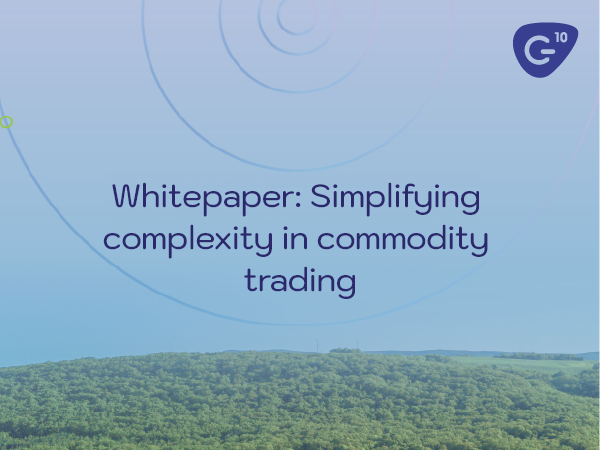Logistics professionals are used to operating under challenging circumstances, acting with agility, and managing the risks that come with disruptions in global shipping. However, the scale of the current challenges in commodities shipping, combined with the ever-increasing threat from competitors embracing digitalisation, mean that it is becoming increasingly important to integrate these logistics operations into the wider business operating system.
This helps traders and risk managers act on the latest picture of your inventory and positions, whether stock is warehoused or at sea, and allows operators to get on with managing complex logistics whilst being supported to remain within your processes and controls with minimal obstruction or repetition of work.
What’s changing in shipping?
Disruption to global trade routes
Anyone in global commodities shipping is used to working around localised disruption from weather and geopolitical events, to say nothing of the global disruption we saw during the Covid-19 pandemic. Commodity supply chains demonstrate remarkable resilience in the face of geopolitical disruption, for example, Ukrainian grain exports continue, albeit at a reduced level, but trends in Ukrainian exports are becoming less important to overall expectations for global commodity markets, which have now adapted to the ongoing situation.
However, with disruption to both the Panama and Suez Canals, global trade routes are shifting dramatically and causing new problems for logistics operators and traders. The Panama Canal has been facing an extended period of drought that has been limiting traffic for almost a year. Daily transit slots have recently risen to 24, after having been at 18 since February 2023, although this still remains far below the usual 36 daily transit slots. The question now is how long this disruption will continue, and how long we refer to it as disruption before it becomes the new normal.
And traffic in the Suez Canal is also severely reduced due to ongoing hostilities in the Middle East making the Red Sea a dangerous route that many shipping lines are choosing to avoid. 12% of annual trade typically passes through the Red Sea, so with more operators diverting around the Cape of Good Hope, there could be long-lasting impacts on commodity shipping. The longer route adds around 10 days on to journeys to northern Europe, which means higher fuel usage, crew wages, and other operating costs, as well as causing delays and reducing ship availability. This is already also translating to increased shipping costs – the cost of container transport increased 15% in one week in January, and with energy cargoes among those being diverted, fuel prices more generally could be set to rise shortly.
Decarbonisation
The drive for energy efficiency in shipping has meant that ships have been slow steaming for up to a decade, and sailing speeds may reduce further as carbon emissions targets become increasingly common and urgent. This could put further strain on capacity, as reducing speed by 1 knot brings down the available supply-side tonnage by around 3-5%.
Decarbonisation is an increasingly global affair, with different legislatures and the IMO increasingly mandating changes that will affect all in the shipping industry. The IMO is targeting net zero emissions from international shipping by 2050 and a 40% reduction by 2030. And the current redistribution of traffic away from the most efficient shipping routes can only make these targets harder to achieve.
This decarbonisation drive may also introduce more optionality into shipping markets as alternative fuels have been identified by the IMO as a core component of meeting this target. These alternative fuels are becoming more widely available, but their impact on the market is still uncertain. At the moment, they can cost up to 50-150% more than conventional fuels, so may further drive up shipping costs. Or, with many organisations looking to minimise their supply chain emissions, fuel optionality could lead to traders and commodity merchants being able to command a green premium for journeys using less carbon-intensive fuels.
Carbon offsetting is another trend that we could see accelerating, both on a voluntary basis and due to incoming legislation. For example, the EU’s Emissions Trading System covers emissions from maritime transport from 2024. Vessels calling in at EU ports will need to buy credits on the European carbon market to offset their emissions. Operators currently receive some free carbon allowances, but these will be reduced over time, creating more market value for the credits and also incentivising companies to reduce their emissions so that they can avoid purchasing credits, or sell their remaining allocation to others.
The ageing fleet
The green energy transition is not one simple, unified process, and this is one factor contributing to the global shipping fleet being at its oldest age in almost 15 years – as there is hesitancy in the market to order greener vessels when the fuel supply is uncertain, and when there are many uncertainties over green legislation too.
Other factors contributing to the ageing fleet include the growth of the “grey fleet” transporting Russian oil around Western sanctions. Whilst there is awareness that older vessels are being repurposed as part of this fleet rather than being scrapped, by nature it is difficult to ascertain the real scope of these operations. And shipbuilding programmes have also stalled recently, particularly for bulkers and tankers.
The ageing fleet can cause several challenges in logistics. Firstly, older vessels are more prone to wear and tear, and may have fewer modern safety features and navigation aids, all meaning a higher chance of incidents that compromise safety and cause shipping delays.
Older ships can also introduce a greater administrative burden as they can be built to varying safety standards and may not necessarily meet all modern regulations. The IMO does not require older vessels to retrofit upgrades as their requirements change, but some jurisdictions do. For example, the US Coast Guard requires all ships operating in US waters to comply with its regulations, regardless of age, which may mean retrofitting, or some vessels are granted exemptions on a case-by-case basis. This means that operators, particularly those chartering vessels, need to be aware of any restrictions on older vessels’ operations, and factor in their increased risk of incidents, as well as having the systems in place to be notified and act with agility if delays do occur.
Responding to disruption
Journeys are getting longer, slower, and more prone to risk, all reducing global shipping capacity and creating more challenges for logistics professionals in commodity trading firms. Operators are expert at anticipating and responding to this disruption, but with the need for greater agility and more proactive risk management comes the need to change how logistics is viewed within the trading organisation.
Incorporating logistics more closely with trading and risk management functions provides benefits to logistics professionals, who can get a better picture of the live situation and ensure other teams are better aware of inventory, vessels, and risks. As well as improving inventory management, operational risk controls, and supply chain optimisation.
In part 2 of this article, we will be exploring exactly how logistics can be more closely integrated with the rest of the business, unlocking benefits for all teams, whilst ensuring logistics professional maintain their authority and ownership over their operations.
Want to read more?
Subscribe now for monthly updates
By submitting your details you agree that we can store your data and communicate with you. You can opt out of these communications at any time. Read all in our Privacy Policy.



